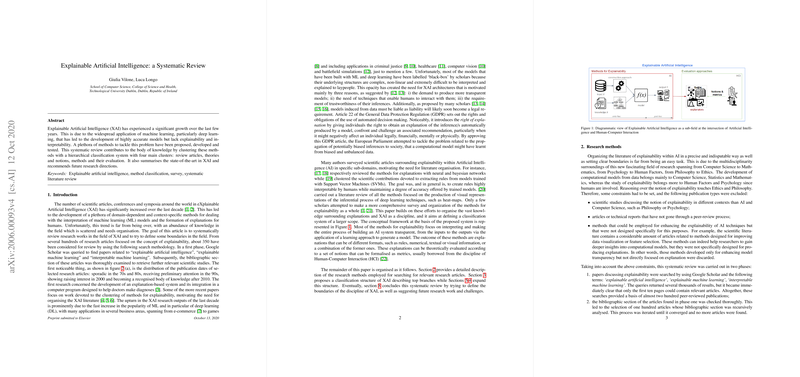Overview of "Explainable Artificial Intelligence: a Systematic Review"
The paper "Explainable Artificial Intelligence: a Systematic Review" by Giulia Vilone and Luca Longo provides a comprehensive analysis of methodologies pertaining to Explainable Artificial Intelligence (XAI). As the machine learning domain, particularly deep learning, has expanded, the necessity for interpretability and explainability in these models has become paramount. This review attempts to organize and categorize the vast array of methods proposed to address this requirement into a coherent hierarchical classification. The paper segments the methods into four main clusters: review articles, theories and notions, methods and their evaluation.
Key Contributions
- Categorization and Methodologies: The paper organizes 350 research articles into a hierarchical classification system, offering a structured overview of XAI methods. Four main categories emerge from this structure:
- Review articles: These include literature reviews and systematic surveys about explainability methods.
- Theories and notions: This category evaluates the foundational concepts underlying XAI.
- Development of methods: This encompasses articles focused on creating new methods to enhance explainability.
- Evaluation strategies: These are concerned with assessing the effectiveness of explainability techniques.
- Historical Context: The paper traces the history of explainability in AI, noting the sporadic interest from the 70s and 80s, a gradual increase in the 90s, and a significant surge post-2010. This historical analysis provides context for the current proliferation of XAI methodologies.
- Research Methodologies: The authors describe their rigorous research methodology involving the use of Google Scholar to identify relevant papers, followed by detailed examination of their bibliographies to extract further studies. This methodology ensures a wide and comprehensive coverage of existing research.
- Evaluation Criteria: Various evaluation criteria for XAI methods are discussed, including the attributes of explainability, types of explanations, and structures of explanations. This section aims to provide a basis for assessing the effectiveness and suitability of different XAI methods in practice.
- Challenges and Recommendations: The conclusion synthesizes the insights gained and outlines the challenges facing the XAI field, suggesting a unified framework for organizing XAI research to better guide future exploration and development.
Implications and Future Directions
The paper's systematic review contributes significantly to the field by organizing scattered research into a structured knowledge base. The authors highlight the necessity of using interpretable models in high-stakes applications such as healthcare, finance, and criminal justice.
- Unified Framework: The review suggests moving towards a unified framework that integrates various strategies for model interpretability. This includes blending connectionist approaches with traditional symbolic reasoning methods.
- Human-Centric Evaluation: There is a call for more human-centric evaluations of XAI methods, involving end-users extensively in the design and assessment of explanation interfaces. This emphasizes their role in making practical, user-friendly explanations.
- Interdisciplinary Approaches: Future research should continue to integrate findings from social sciences, psychology, and philosophy to enhance the comprehensibility of AI explanations.
- Legal and Ethical Considerations: The review acknowledges the importance of considering legal frameworks such as GDPR in the design of explainable models to ensure compliance and trustworthiness.
In summary, this systematic review not only provides a detailed and organized synopsis of the existing methods and approaches in XAI but also lays out a roadmap for future research directions, emphasizing the importance of interdisciplinary collaboration and user-centered design in creating effective AI explanations.
